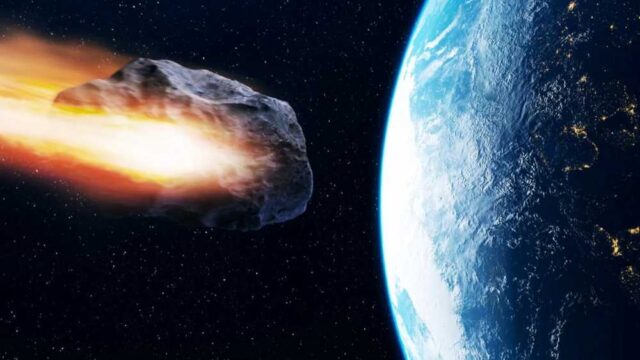A massive space rock, ominously named “City-Killer” Asteroid 2024 YR4, is hurtling through space with a small but alarming chance of striking Earth on December 22, 2032.
Discovered in December 2024, this asteroid has garnered significant attention from astronomers and space agencies worldwide. Currently, the probability of an impact is 3.1%, which is the highest likelihood ever recorded for a large asteroid.
The possibility of a city-leveling disaster has led NASA, the European Space Agency (ESA), and other organisations to closely monitor the asteroid’s trajectory. But what does this mean for Earth, particularly for densely populated regions such as Mumbai, Bogotá, and Lagos?
What Makes 2024 YR4 A ‘City-Killer’?
Unlike the six-mile-wide asteroid that wiped out the dinosaurs 66 million years ago, 2024 YR4 is much smaller—estimated to be between 130 and 300 feet wide. However, despite its relatively modest size, it has the potential to unleash devastation akin to that of a hydrogen bomb.
Experts suggest two possible scenarios: atmospheric disintegration, similar to the Tunguska event in 1908, which flattened 2,000 square kilometres of Siberian forest, or direct impact, which could create a crater and cause city-wide destruction. Given the asteroid’s projected path, major population centres are keeping a wary eye on its movements.
Who Is At Risk?
Recent NASA simulations suggest that the impact corridor stretches from the eastern Pacific Ocean to South Asia, covering regions with millions of inhabitants. Major cities in the potential danger zone include Bogotá (Colombia), Lagos (Nigeria), Mumbai (India), Dhaka (Bangladesh), and Abidjan (Ivory Coast).
If the asteroid were to strike any of these areas, the consequences would be catastrophic. Scientists also caution that even if 2024 YR4 does not directly collide with Earth, it could explode in the atmosphere with a force over 500 times more powerful than the Hiroshima bomb, causing widespread damage.
What Destruction Will It Cause To Mumbai And India?
An asteroid impact on Mumbai would be catastrophic. The city, with its high population density and coastal location, would face massive destruction. A large asteroid could trigger tsunamis, fires, and earthquakes, wiping out infrastructure and leading to an immense loss of life.
The economic hub of India could be crippled, causing nationwide financial instability. Beyond Mumbai, the impact could send shockwaves through the entire country, disrupting communication, trade, and essential services. The environmental consequences would also be severe, with dust and debris potentially affecting climate patterns for years.
According to NASA, an asteroid larger than 140 metres in diameter has the potential to cause regional devastation. If an asteroid of one kilometre or more were to strike Mumbai, it could result in tens of millions of deaths.
A study by the National Institute of Advanced Studies (NIAS) in India suggests that an impact of this magnitude would lead to a financial loss of over $1 trillion, severely impacting India’s economy.
Indian astrophysicist Dr Mayank Vahia emphasises the need for better asteroid tracking systems and planetary defence strategies to mitigate potential threats.
Why Scientists Expect The Risk To Decrease
Although the current probability of impact stands at 3.1%, astronomers expect this figure to fluctuate as more observations refine the asteroid’s trajectory. Bruce Betts, chief scientist at the Planetary Society, reassures that “at some point in the next few months to a few years, the probability will go to zero.”
This phenomenon was previously observed with asteroid Apophis, which initially raised alarms but was later ruled out as a threat. NASA’s upcoming observations in March and May 2025 using the James Webb Space Telescope will further refine estimates, likely reducing the impact risk significantly.
Also Read: You Might Get Better Signal On The Moon: The Moon To Get 4G Network
What Are The Possible Deflection Strategies?
If the asteroid’s trajectory does not change favourably, scientists have several options to prevent disaster. The most tested method is kinetic impact, as demonstrated in NASA’s 2022 Double Asteroid Redirection Test (DART), where a spacecraft successfully altered the orbit of Dimorphos, a 160-metre-wide asteroid.
If needed, multiple spacecraft could be sent to nudge 2024 YR4 off course. Other strategies include the gravity tractor method, where a large spacecraft could pull the asteroid away without touching it, and using ion thrusters to push it gently over time. In extreme cases, nuclear detonation remains a last resort, though it risks fragmenting the asteroid into smaller pieces that could still hit Earth.
The Ethical And Political Dilemmas Of Space Defense
While asteroid deflection techniques have been explored in scientific settings, implementing them in reality presents logistical and ethical challenges. Who would make the final decision? Which country would lead the operation?
The involvement of nuclear weapons adds another layer of complexity, as international treaties prohibit the use of nuclear explosions in space. Even a successful deflection could bring about geopolitical concerns—imagine if an intervention redirected the asteroid from one country’s major city to another’s?
These dilemmas emphasise the need for a global cooperative effort to address planetary defence.
If all scientific interventions fail and the asteroid remains on a collision course with Earth, preparation would be key. Experts suggest that having over seven years of advance notice provides ample time for evacuation plans and impact mitigation strategies.
The affected regions could develop contingency plans, including moving populations, reinforcing infrastructure, and stockpiling emergency supplies. Richard Moissl, head of ESA’s planetary defence office, stresses that even in a worst-case scenario, “we are not defenceless.”
While the thought of a ‘city-killer’ asteroid heading towards Earth is unsettling, it is crucial to maintain perspective. The probability of impact remains low, and ongoing observations will likely decrease it further. More importantly, modern science provides humanity with unprecedented capabilities to detect, track, and even alter the paths of celestial threats.
With international collaboration and strategic preparedness, the risk posed by 2024 YR4 can be effectively managed. As NASA and other space agencies continue their vigilant monitoring, we can remain hopeful that this cosmic visitor will ultimately pass by without incident.
Image Credits: Google Images
Sources: First Post, Times Of India, NDTV
Find the blogger: Katyayani Joshi
This post is tagged under: asteroid impact, Mumbai disaster, India crisis, space threat, asteroid collision, natural disasters, Mumbai safety, space science, NASA updates, asteroid warning, global catastrophe, climate impact, economic crisis, disaster preparedness, future threats
Disclaimer: We do not hold any right, copyright over any of the images used, these have been taken from Google. In case of credits or removal, the owner may kindly mail us.




































